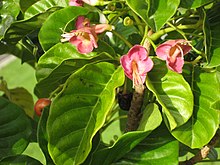Vitex lucens
The plant was excellently described by Solander in his manuscript "Primitae Florae Novae Zelandiae" under the name Ephielis pentaphylla, and a drawing of considerable artistic merit was also prepared.[1] The next botanist to notice pūriri, Allan Cunningham, did not do so until 1826 when he observed it on "the rocky shores of Bay of Islands, growing frequently within the range of salt water."The pūriri tree can grow up to 20 m tall, with a trunk commonly up to 1.5 m in diameter, frequently thicker, and a broad spreading crown.When the flower is fully open the style starts growing and reaches its full length just after the anthers on the stamen have shed all the pollen.Pūriri is a very important tree for native birds in the top half of the North Island because it provides a constant year-round food supply.It is hoped that restoration planting, with trees such as pūriri, will provide a year-round food source for birds, boosting their populations.Maintaining kererū populations is particularly important for natural restoration and maintenance of forest remnants, as this bird is the main disperser of large fruited species.[11] The wide spreading branches also provide room for epiphytic species such as Astelia, puka (Griselinia lucida) and northern rātā (Metrosideros robusta).European settlers used great quantities of pūriri timber for fence posts, railway sleepers, shipbuilding and house blocks, as it is ground durable without treatment for 50 years or more.[17] Pūriri was also favoured for furniture and decorative wood work such as inlay veneers, as its appearance was "quite equal to the best Italian or American walnut".Other potential roles for pūriri include post, wharf and bridge pilings, as pine requires a high degree of preservative treatment and can break too readily under pressure due to lack of cross-grained wood.[24] Indications are that pūriri could coppice well, and, as it is one of New Zealand's most demanded burning timbers,[10] it might prove suitable as a source of biomass or for charcoal production.







Thames, New ZealandPuriri, New ZealandHMNZS Puriri (T02)AucklandScientific classificationPlantaeTracheophytesAngiospermsEudicotsAsteridsLamialesLamiaceaeBinomial nameNew ZealandTolaga BaySolanderAllan CunninghamBay of IslandsThomas KirkRuapekapekapalmatekohekoheNorthlandstamenNorth IslandendocarpautogamyendemicWaikatoMāhia PeninsulaCape EgmontWaipoua ForestTiritiri Matangi IslandHauraki GulfkererūAenetus virescenslarvaenorthern rātādespatch boxeshīnakigreater Auckland provincePinus radiatacoppiceDespatch boxJ. T. SalmonUniversity of AucklandDiocese of New ZealandWikidataWikispeciesiNaturalistOpen Tree of LifePlant ListTropicos